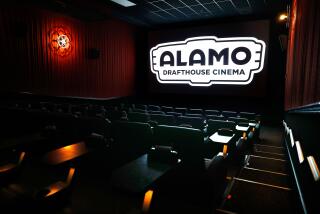Now showing in rich people’s homes: first-run movies
They were planning to spend nearly $500,000 on a home theater. What was an additional $35,000 to show first-run movies?
When Ken and Carol Schultz began remodeling their 10,000-square-foot San Diego-area residence, they spared no expense on a screening room. The couple tricked it out with custom-built armchairs with heat and massage functions, and a Runco 3-D-capable projector with a price of about $100,000.
But the most unusual feature of the theater is a $35,000 device that offers 24-hour rentals of first-run movies. For $500 a film ($600 for 3-D), the Schultzes can show movies the same day they screen at the local multiplex.
PHOTO: All-time top movies at the box office
The Schultzes are not members of the exclusive “Bel-Air circuit” — a few hundred producers, writers, actors and executives who mostly live on the Westside and receive copies of first-run films from movie studios, often just as they’re released to theaters.
Instead, these Rancho Santa Fe film fans, who also own a West Hollywood condominium they bought from actor Matthew Perry, are willing to pay a premium to screen movies as the Hollywood moguls do.
They didn’t blink at the cost of the movies or the system, built by Prima Cinema Inc.
“When the projector costs three times that, you don’t pay attention to the Prima cost,” said Ken Schultz, an energy company investor who made his money in solar panels. “We have boxes at the Hollywood Bowl, and we go to Disney Concert Hall to see Dudamel. Even if we watch 10 to 12 movies a year on Prima, it is still a fraction of our overall entertainment budget.”
The Schultzes are self-described film buffs and prominent donors to the UCLA Film & Television Archive. They recently used the system to screen the comedies “Admission” and “Identity Thief” in their Art Deco home theater. They did it on the same weekends the pictures opened in theaters.
Prima, which was founded in 2010 and launched its service last year, is banking on more customers like the Schultzes. The Carlsbad, Calif., company’s chief executive, Jason Pang, declined to disclose sales figures but said Prima needs to tap only a small percentage of the total number of very affluent Americans to be successful.
“There are thousands of people out there, if not tens of thousands of people, that could buy this product,” Pang said. “We found the secret sauce to make billionaires act like little giddy schoolchildren.”
A survey of 1,000 U.S. home builders found that 29% of residences they built in 2011 included home theaters, up from 20% a year earlier, according to market research firm Parks Associates.
Patrick Calderone, president of AVX Design & Integration, a West Los Angeles home theater design and installation firm, is one of 15 authorized Prima dealers in the L.A. area. Calderone said that for high-end customers — who spend as much as $2 million on their theaters — the price of the device is in line with other components. He added, though, that “telling someone the movie is $500 to watch is the only time you see them wince, even though they probably spend that when they go to dinner with their wife.”
So far, Prima has deals with Universal Pictures and independents Magnolia Pictures and Cinedigm. It also offers movies from Universal’s Focus Features division and is said to be in talks with Lionsgate to carry the company’s films.
Prima may not pose much of a threat to the Bel-Air circuit. Pang conceded that folks on the circuit already enjoy a high level of convenience but said that access to films is dependent on relationships: “Just because you are on the Bel-Air circuit doesn’t mean you have a relationship with every studio.”
There are also costs to the circuit. Many people who receive films from studios are required to hire a courier who, for a fee of at least $250, will retrieve a digital copy of a movie and then return it to the studio.
And old-school circuit members who still use 35-millimeter projectors must hire projectionists, who typically charge $90 an hour with a four-hour minimum, said Jess Daily, the former chief projectionist at UCLA’s James Bridges Theater, who runs screenings for three people on the circuit.
At least one member of the circuit was skeptical of the Prima service.
“The speed of technological change … and the reality of spending $35,000 for, say, that 40 times you watch it in your screening salon, and $500 a pop for the privilege, is a poor investment that will get little traction,” said Peter Guber, the former head of Sony Pictures Entertainment who is now chairman of Mandalay Entertainment Group, in an email.
If it is successful, Prima could run afoul of the country’s movie theater owners, as Universal Pictures did when, in 2011, the studio planned to offer its “Tower Heist” via video-on-demand services three weeks after the comedy hit theaters. The movie would have cost $60.
Universal, which is an investor in Prima, scuttled its plans after theater owners said they would refuse to show “Tower Heist” if the studio followed through with the experiment.
That same year, DirecTV rolled out a service in conjunction with four studios that offered rentals of films 60 days after their theatrical releases for $30. There was little demand for it.
But film executives who support Prima don’t believe the service will adversely affect exhibitors.
“Nobody I’ve talked to thinks Prima will be cannibalistic, because the clientele is too exclusive — their customers aren’t likely to go to theaters often, if ever,” said Adam Fogelson, chairman of Universal Pictures, whose parent company NBCUniversal is owned by cable giant Comcast Corp.
The National Assn. of Theatre Owners did not respond to requests for comment.
Prima’s high price should ensure it remains a niche product. Pang said Prima is “locked in at $500,” and that pricing for 3-D films is higher because they require larger data files than 2-D movies. The service began showing Universal’s 3-D version of “Jurassic Park” on Friday at $600 a viewing.
The Schultzes use Prima about once a month and enjoy gathering with friends in the home theater, which features a roughly 8-by-18-foot screen, walnut-paneled walls and seating for eight. The ability to watch movies such as Universal’s “The Bourne Legacy” as they are unfurling in theaters makes the high price worth it, Ken Schultz said.
“The question with Prima is always ‘Gee, look at the cost of doing that,’” he said. “The thrill of it is you are in the comfort of your own home.”
MORE
INTERACTIVE: TVs highest paid stars
ON LOCATION: People and places behind what’s onscreen
PHOTOS: Hollywood back lot moments
More to Read
From the Oscars to the Emmys.
Get the Envelope newsletter for exclusive awards season coverage, behind-the-scenes stories from the Envelope podcast and columnist Glenn Whipp’s must-read analysis.
You may occasionally receive promotional content from the Los Angeles Times.











